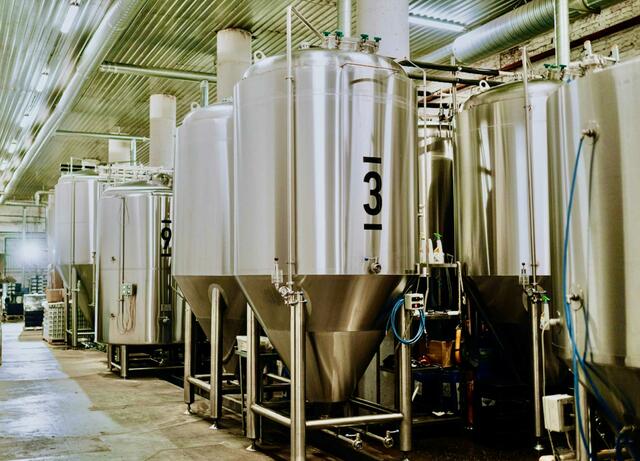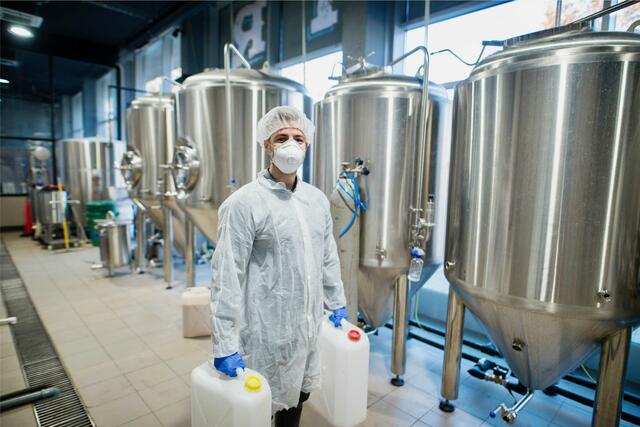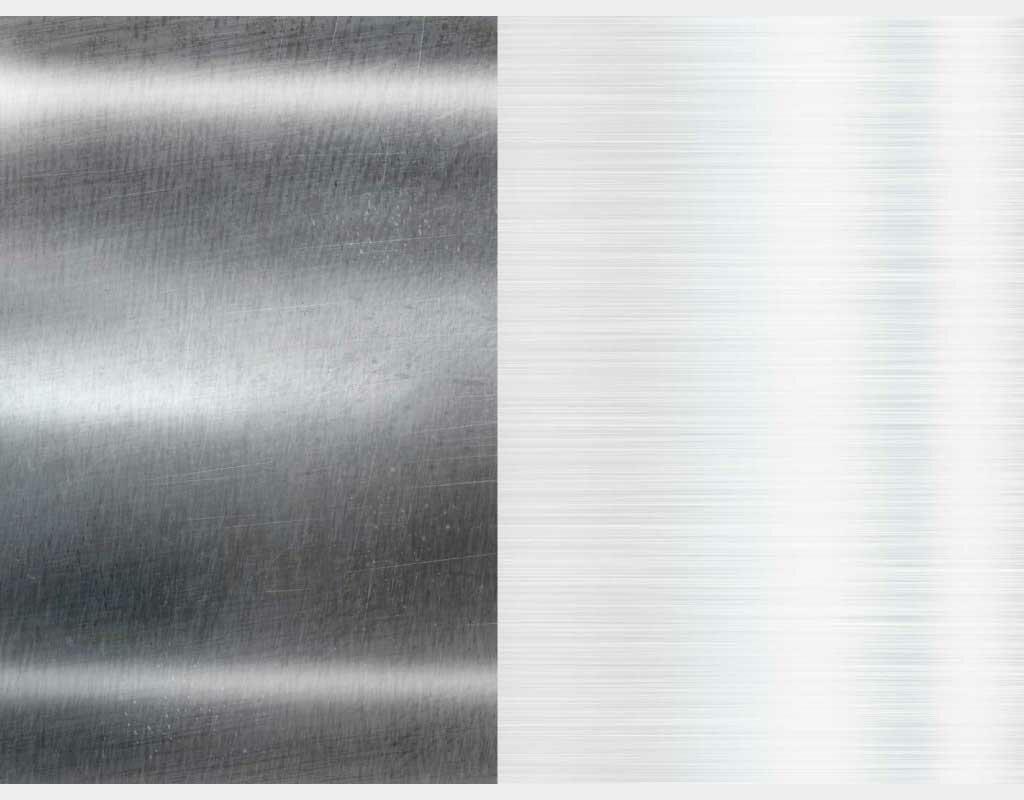How do I choose between a flat, sloping or conical tank bottom?
Complete guide
In industrial processes, the choice of tank design is not just a question of capacity; it has a profound effect on productivity and storage efficiency. Choosing the right tank bottom - whether flat, sloped or conical - can facilitate residue flow, optimise emptying and simplify cleaning, making operations smoother and more profitable. In this article, you'll find out how to select the ideal tank bottom for your needs, whether for storage, drainage or fermentation, and how these choices can make a difference to your industrial productivity.
Types of tank ends: characteristics and definitions
Flat tank bottom
• Description and features
The flat tank bottom is the simplest and most common option in industrial installations. This type of bottom is characterised by a horizontal surface that ensures great stability and optimum use of storage space. Flat-bottom tanks are often chosen for the storage of non-viscous or low-density products, where flow is not a key priority.
• Advantages for specific applications
The main advantage of a flat-bottom tank is its ease of manufacture and affordability, making it an economical choice for applications where rapid emptying is not essential. These tanks are ideal for prolonged storage, particularly in industries where cleaning and product rotation are less frequent. In addition, the simplicity of the design makes these tanks easy to integrate into a variety of installations without the need for additional support or tilting.

Sloping tank bottom
• Description and features
The sloping tank bottom is designed with a slight slope that facilitates the natural flow of liquids and residues towards a discharge point. This type of bottom is often preferred in industries where the products stored are more viscous or require more effective drainage. The slope allows residues to be channelled to the discharge point, reducing the need for complex cleaning manoeuvres.
• Advantages for draining viscous residues and simple drainage
Sloped-bottom tanks are ideal for applications where complete drainage is required, as in the case of certain food or chemical liquids. Thanks to the incline, residues are directed more efficiently, reducing product losses and facilitating the cleaning process. This type of bottom is often used in the food or cosmetics industries, where the management of viscous residues is crucial to maintaining optimum hygiene and minimising waste.

Conical tank bottom
• Description and features
The conical tank bottom, as the name suggests, is shaped like an inverted cone. This design allows liquids and residues to be completely drained by gravity. The conical bottom is commonly used in fermentation applications, such as brewing tanks, because it allows solid residues or yeast deposits to be easily separated and removed, without the need for additional handling.
• Frequent applications, particularly in fermentation tanks
Fermentation tanks with conical bottoms are widely used in the brewing industry, but also in the chemical and food sectors, where the emptying process is crucial. This type of bottom optimises flow, making it the preferred choice for applications requiring rapid and complete drainage. By reducing the build-up of residues, conical tanks also make cleaning easier, ensuring a more hygienic environment that meets industry quality standards.

Criteria for choosing the right tank bottom
Type of fluids and products stored
The nature of the fluids and products stored in a tank plays a crucial role in the choice between a flat, inclined or conical tank bottom. Factors such as the viscosity of the liquid, the corrosiveness of the chemicals or the specific characteristics of food products can have a direct influence on the functionality of the tank bottom.
Some fluids, such as oils or viscous substances, require an optimised flow, which can make inclined or conical bottoms more suitable for avoiding stagnation. For example, a fermentation tank with a conical bottom allows residues to flow naturally, making it easier to drain and clean thicker products. Conversely, for less sensitive products, a flat tank bottom may suffice, offering an economical and effective solution.
Taking into account the chemical nature of the products, stainless steel tanks are often preferred for corrosive substances, guaranteeing both resistance and longevity. Choosing the right tank bottom will not only optimise storage, but also reduce maintenance costs.
Types of application
Different industrial applications, whether for fluid storage, fermentation or chemical management, require specific tank ends to ensure efficiency and safety. The choice of tank bottom should not be left to chance, as it has a direct impact on production processes.
For fermentation applications, a conical bottom is often essential. Not only does it make it easier to collect fermentation residues, but it also ensures a smooth flow. On the other hand, when storing non-corrosive products or low-viscosity liquids, a flat or sloping tank bottom can offer an excellent compromise between ease of use and cost. For particularly reactive substances, tanks with sloping bottoms facilitate drainage, limiting the risk of cross-contamination between two production cycles.
By choosing the tank bottom to suit the application, companies can streamline their processes and avoid wasting unnecessary time during cleaning or product transfer.
Draining and cleaning considerations
Emptying and cleaning operations are critical stages in the management of industrial tanks. The right tank bottom not only facilitates complete product evacuation, but also guarantees effective cleaning, which is essential for maintaining health and quality standards.
A conical tank bottom is ideal for processes where complete emptying is essential, as its shape allows almost complete evacuation of residues. This is particularly useful for food and fermentation applications where cleanliness is crucial. On the other hand, a sloping bottom can also facilitate the flow of liquids and simplify the drainage process, especially for low-viscosity liquids. In less demanding contexts, a flat bottom may be sufficient, but may require additional equipment to ensure complete drainage, which can increase operating costs.
By taking into account tank bottom cleaning needs and flow requirements, companies can optimise their operational efficiency while reducing the risk of contamination and extending the life of their equipment.

Specific applications and use cases
Fermentation tanks : conical bottom recommended
In the fermentation sector, the choice of a conical tank bottom is particularly recommended because of its efficiency in draining and collecting residues. This type of tank allows solids and sediments to flow naturally to the bottom, making it easier to empty the tank completely without residues. In this section, we'll explore how a conical bottom optimises fermentation processes, reducing the need for frequent handling and minimising product loss. Whether for the production of beer, wine or other fermented beverages, the use of a conical bottom fermenter ensures consistent quality while simplifying the cleaning and maintenance process.
The conical shape also helps to manage the concentration of yeast and sediment, which is often reused in fermentation processes. This self-separation process ensures greater fermentation efficiency, flavour stability and a more controlled texture in the final product. This tank configuration is also particularly prized for its durability and its ability to reduce manual intervention.
Chemical storage tanks : criteria for corrosive products
When it comes to chemical storage tanks, bottom features play a vital role in ensuring safe and efficient storage, particularly for corrosive substances. Tanks with sloping bottoms offer a considerable advantage for rapid and safe drainage, limiting the risk of accumulation of hazardous residues. In this section, we will look at the reasons why a sloping bottom is often preferred for the storage of aggressive chemicals, in particular by facilitating rapid and safe drainage of the stored substances.
The choice of a sloping bottom is also strategic for reducing cleaning times, which is essential when handling chemicals that require rapid and complete emptying. Reducing stagnation zones minimises the risk of undesirable chemical reactions in the residues that remain. This makes sloped-bottom storage tanks ideal for demanding industrial environments, where safety and corrosion resistance are paramount.
Food tanks: cleaning and safety requirements
In the food sector, where hygiene and safety are paramount, flat-bottomed tanks are often preferred for their ease of cleaning. A flat tank bottom allows optimum access to internal surfaces, ensuring thorough and rapid cleaning, essential to avoid cross-contamination. In this section, find out why a flat bottom meets the stringent requirements of the food industry, particularly for the storage of sensitive liquids and raw materials.
Flat-bottom food tanks reduce hard-to-reach areas, minimising food residues and contributing to better sterilisation between production runs. In environments where compliance with health standards is crucial, these tanks not only guarantee safe storage but also improve operational efficiency, as they simplify regular maintenance and inspection protocols.

In short, choosing the right type of tank bottom - whether flat, sloped or conical - is essential for optimising the storage, residue drainage and cleaning of your industrial tanks. Each option offers specific advantages: the flat bottom is often an economical solution for basic storage, the sloping bottom allows better management of partial drainage, while the conical bottom guarantees complete emptying, ideal for applications requiring impeccable cleanliness. By taking into account your emptying and cleaning requirements and the type of product, you can select the most suitable tank to improve the efficiency of your operations. Whether you're in the food, chemical or beverage industries, making the right choice of tank bottom is a strategic investment in uncompromising production.
✖ Any doubts about the feasibility of your project?
Please do not hesitate to contact an Arsilac manager if you have any questions or if you would like more information on the types of valves used in industry. Find the valve solution that meets your needs.
_
Note: This article is for information purposes only and does not constitute professional advice. It is recom
FAQ on types of tank bottom
Q : How do I choose between a flat, sloping or conical tank bottom ?
A : To decide between a flat, sloping or conical tank bottom, you need to analyse the intended use and the type of product. For example, conical tank bottoms are often chosen for fermentation tanks, because they facilitate bottom drainage and optimise the flow of residues without excessive intervention. Sloping bottoms offer a versatile solution for viscous liquids, allowing rapid drainage without compromising on cleaning. Flat bottoms are more economical and suitable for stable products, although they may require more frequent maintenance to prevent build-up. The choice of tank bottom must therefore be strategic and based on the specific features of the industrial application.
Q : Why use a sloped-bottom tank for viscous liquids ?
A : Using a sloped-bottom tank for viscous liquids offers many advantages in industrial processes. Thanks to its sloping design, this type of tank facilitates bottom drainage, reducing residues and the need for auxiliary pumps to drain thick products. The food and chemical industries often choose this type of bottom to improve the efficiency of bottom cleaning and reduce maintenance costs, since residues adhere less to the sloping walls. This makes sloped tank bottoms an ideal option for viscous liquids requiring rapid drainage and minimal maintenance.
Q : How do I choose a tank bottom suitable for corrosive chemicals ?
A : When storing corrosive chemicals, a tapered stainless steel tank bottom is often the best choice. This type of bottom helps complete drainage, limiting residues that could damage the tank over time. Industrial tanks made from corrosion-resistant materials, such as stainless steel, guarantee greater safety and durability in the face of aggressive chemicals. Sloping tank bottoms are also suitable, provided that the tank is drained regularly and the material is resistant to chemicals, to ensure the equipment's longevity.
#cuveinox #fonddecuve #fondplat #fondincline #fondconique #cuveindustrielle






